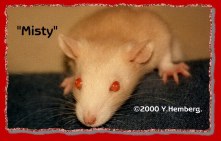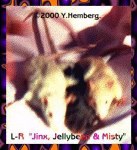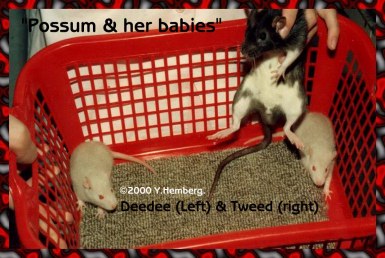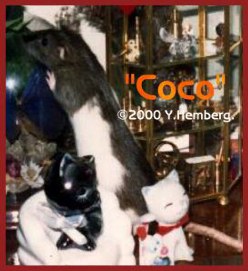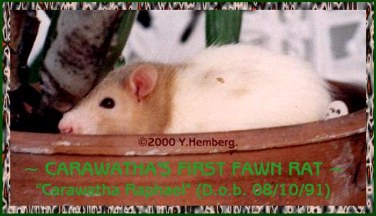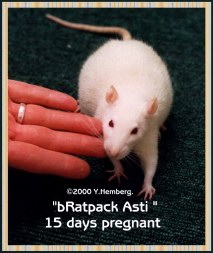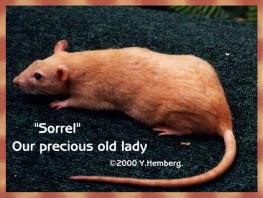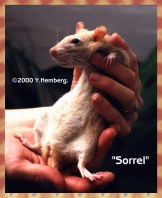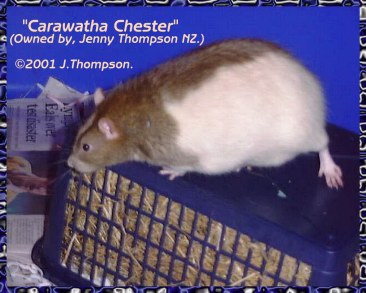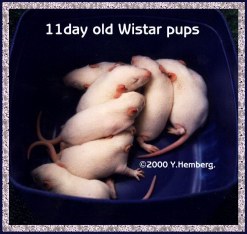CARAWATHA RATS
My first rat was a little silverfawn hooded girl, named "Misty", given to me by a friend(Theresa) for my birthday, back in 1986.
At this time I was in the cavy fancy, having been introduced by a school friend(Matt), who was also involved in the mouse fancy, being one of the people to start the first mouse club in Qld back in 1994. He's also been involved in the rat fancy since. Not long after getting Misty,(around 3 months in fact) I was introduced to the next rattie, I would take home. A black hooded girl named "Jellybean" also from Theresa.
My next two rats came from Petcetra in Mitchelton, a little dove hooded boy I named "Jinx" and a little mismarked black cardigan girl called "Possum". Well cute little Jinx with the not-so-little family jewels, was in demand, as I began breeding my first ever ratty litters.
Misty had 14 babies, 9silverfawns and 5 doves, all hooded. Jellybean had 12, 5 black and 7 dove also all hooded & Possum had 2 lovely little dove cardigan daughters(pictured above), of which I kept one "Carawatha Deedee".
After these litters it was decided that we'd (more my folks than me) have Jinx neutered. Back in '86 surgery on a rat was pretty much unheard of, and even riskier than it is today. Although he woke up from the surgery and seemed to be doing well, we found him passed away in his cage 5 days later. After this we didn't get another boy until 1989.
At the end 1988 my lovely ratties all passed away of old age, and it took me a few months before I even felt like getting any to replace them. When I did decide to look in the ratty section of my local pet shop I noticed an agouti hooded female that was over twice the size of the other younger, paler ratties in the tank with her.
She was sitting in one of the corners looking rather sad, I just wanted to reach in and pick her up, & when she looked up at me with that 'come rescue me' look, that I'm sure so many of you are familiar with, I couldn't resist.
I reached in to let her sniff my hand, and she climbed right on. That day I gained a new friend and the rattie that would be the start of Carawatha Rodents officially. We still have her line today, It's attained the name sad-sack.
Can you believe, the pet shop staff actually tried to warn me off her, saying she was not to be trusted and was bad tempered. Throughout her whole life we never saw any of the so-called bad behavior.
We had to pick a name for this lovely rattie, She was very long in body, and her movements so graceful, we decided to call her "Coco Chanel", as we're sure that in the rattieworld she'd have to be model material.
SPUD'S STORY
One night I got a call from a girl I knew, asking if I wanted to take her rat, because it didn't like her boyfriend and he was getting sick of it. This is how we came to adopt our second ever rattieboy.
It was obvious right from the start that he had been abused in some way. He was so timid and scared, especially of men. It took me a bit over 3 months before he would trust me enough just to wander out of his cage and onto my lap. We had his cage in the living room so he was around us all the time. If we were there then his door was open.
It was during this 'taming' period that he gained his name. We called him "Spud" because of his unbelievable appetite for potato in any way,shape or form.
"Spud" quickly became my mum's favorite rattie, and he learnt the exact time each morning that mum had morning tea, and came to give him a fresh date as a treat. "Spud" was such a gentle rat, he never once tried to bite any women, even though in his early days he did try it a few times with men. He finally accepted men in general a bit over a year after we got him. My boyfriend at that time was so amazed at the turn around in "Spud's" attitude toward him that he became a ratlover after this, and ended up getting his own rattie, a girl named "Muffin" a few months later.
I cried my first tear of rattiejoy because of "Spud". About 2 months after he'd come out of his shell (so to speak), he wandered over to me, & climbed up onto the back of the couch, one evening while I was watching T.V.
I noticed him doing this, but didn't try to pick him up or anything, as he was still a little wary of this, you had to give him plenty of notice that you were going to touch him or he'd get a fright and dash off.
Well he just sat there, seemingly staring at me for a few minutes, and then he scuffled over closer to me, placed his front paws on my right shoulder, and reached over and licked me a couple of times on my cheek. It was like his way of saying - '"Thank-you for being patient, for not giving up on me", and I'm not ashamed to say, it made me cry, and I still get tears in my eyes when I think of this today.
After that night, he never flinched again when I touched him or picked him up. It was like the turning point where he'd decided that I was trustworthy. Because of "Spud" I am all the more willing to give difficult rescue cases the benefit of the doubt. Whereas before we'd give them around 3 months for rehabilitation, I now give them a lot longer and am reluctant to ever give-up.
From the moment "Spud" arrived in our care to that precious evening, was nearly 5 months. When I wrote this page in April 2001, I'd not been able to find any pictures of "Spud". However last week when I was going through some old photos, I found one. Probably the only one of him I have. It's not a clear body shot, but it's a comical one, taken about 6months after we got him. He was on one of his exploring roams, & had made his way into my house-mates work shorts (while he still had them on - lol).
I will scan & upload the photo to be placed with this chapter.
We were to find out over a year later, that the girl we got "Spud" from, had a boyfriend who used to torment the poor little guy, and apparently used to hold him down against the floor/wall of the cage with a ruler, while he took the food bowls in and out. Apparently because he reckoned the Spud used to wait for him and lunge at his throat. "yeah right" is all I have to say. No wonder "Spud" disliked men so much.
"Spud" became "Coco's" partner, and together they started the line of rats that was to be called our sad-sack line. We still have this line today. "Muffin", a little mismarked black bareback girl, was the only other rattie we bought, to be included in this line, after which we bred our own for many many years before any further introductions of new blood was introduced to this line.
We bred our first bareback baby in Fall of '91.
(see pic further down page, of 3 week old ratpups)
In summer of that same year we discovered an unusual baby in one of our young litters. "Carawatha Raphael" was our first fawn hooded rat. At this stage he was being called a ruby eyed apricot. As back then Silverfawn rats were called apricot, and this new type looked like a dark-eyed version of that.
~~~~~~~~~~~~~~~~~~~~~~~~~~~~~~~~~~~
While there has been new blood introduced to our lines from time to time over the 20 years since this line's inception, we've largely stuck to improving on the lines of the three ratties we started with seriously in 1989.
Through keeping detailed records from the very beginning we have ratties today with pedigrees up to 20 generations long going back to Coco & Spud. One of the more recent and very memorable members of this line, is "Leona Little" who can be found on our female rats page.
Up until the last couple of years, Carawatha have bred almost all the breeds, colours and patterns available in Australian fancy rats today. More recently though, the odd-eye, masked, capped and rex varieties have shown in our fancy and we are only now starting to add their diversity to our lines. In fact, about the only breed we haven't bred so far, is Sphynx rats, although some of our DownUnders in the beginning, had these in their pedigrees way back. We've even been lucky enough to witness the spontaneous mutation of not one, but two Manx rats. "C.Maverick", in one of our bareback lines. & "C.Sarabi" from our DU line.
We breed for 'Pet' rats. By this I mean, we pay special attention to their temperament. Where possible we also try to breed to improve the type and colour of the various varieties, by using ANRA's breed standards as a guide.
We have strict guidelines to our breeding practices, and now only breed an average of three litters each year. One or two litters at a time, to ensure we can give the pups enough attention to raise them well.
We choose to breed our females (Does) no younger than 4 months and weighing at least 200grams and more often, not until they are 6months of age. We have found it is usually advisable to breed from a Doe before she is 12months old to lessen any chance she may develop a fatty uterus and in turn be affected by uterine inertia. Although only one of our girls over the years was affected with this, it was a big enough scare to make us consciencious about it.
Female rats should never have more than 4 litters a year. They must have an absolute minimum rest period of 4 weeks between litters. While to some this may not sound like many at all, if you break it down, you'll realise it's a very full schedule.
*Once a rat falls pregnant, she will gestate for approx. 3 weeks, then she lactates for approx. 4-5 weeks, followed by a 4 week rest. Add this up and you get 3 months, multiplied by 4, for the year* Definitely a full schedule.
We prefer for our females to have no more than 2 litters per year, & in fact Most of our females won't have more than that in their whole lives.*
The longevity of our original line is around the 4year mark. Bearing this in mind, our 2-3 year old females are still middle aged, and don't usually look old at all. Hence we have had some rats mother litters when they are over 2 years old themselves. With the exception of one case of uterine inertia back in 2004, we have not had a birthing difficulty, nor experienced runt's or still births from this line.
You can tell the look of an old rattie, they lose muscle tone, and feel rather fragile & saggy to the touch.
This lady is over 3 years old in this photo. We bought her from Petcity in 1995 as an adult, when someone dropped her & her cagemate to them, when they couldn't keep them anymore.
Females from our Sad-sack line average a weight of 400grams and the males 550grams+. With our heaviest ever rattie "C.Banjo" being 820grams. However we were amazed by "Carawatha Chester" one of the ratties from this line who went to NZ. tipping the scales at the 2kg mark!!! a truly amazing size by any standard. Jenny sent us this photo of him in 2001.
~~~~~~~~~~~~~~~~~~~~~~~~~~~~~~~~~~~~~~~
While the females weight/age is the major consideration to breeding, the males also have to be a decent weight, at least 250grams, and at least 3 months of age before being bred.
)}~ <8 (@)}~ <8 (@)}~ <8 (@)}~ <8 (@)}~<8 (@)}~
There are very important reasons why rats should not be bred too early. The most common one that most people would think of is the size of the animals, but this is only one reason. The mother rat needs to be mature enough in herself (ie. past the baby stage, and well on her way to being fully grown skeletally) so that her body is going to be able to provide enough calcium to her young.
Rat mothers provide their female offspring with enough calcium in their systems to last them to their first litter. If the mother is bred too young, then her own system is in need of extra calcium and one of two things may happen. 1. Either the developing ratpups do not receive this calcium reserve from mum and may also have lower bone density themselves and/or be undersized. (Thus future generations will also be affected)
2. Or the mothers own bone density is compromised due to the developing babies within her. Her body will leech calcium from her own bones, in order to develop her young in-utero.
With mother rats bred too young, there is also the issue of how the mother will deal with the babies. It's been observed that some mothers, don't appear to know what they're doing, and may neglect or even hurt their young.
Pregnancy and lactation is very taxing on the female rats system. They need to be in tiptop condition prior to breeding. How the mums fare during the whole process is a very individual thing. We've observed some that seem to be largely unaffected by the whole process, some that have lost considerable condition in spite of eating nearly their own body weight in food daily, and then others who have actually gained bone density and size throughout the time. The way mother rats fare is a hereditary thing to a large degree. Mothers who do well tend to come from a line where all or at least a majority of females in that line also fare well.
When the mothers are lactating we supplement their diets with a number of things. Wholemeal bread soaked in diluted evaporated milk, Nutrigel/energel a pea sized amount a couple of times per week, and regular treats of the protein type, cooked egg and meats. Usually by 2 weeks the babies are sampling foods. We like to supplement their diets with organic toddler foods daily from 2-4weeks of age.
The mothers usually wean the pups themselves and this usually happens around 4 & 5 weeks of age. We don't sell pups under 5 weeks old, and in a lot of cases keep them until they are 7 weeks before selling them. All our pups have been wormed with small animal wormer after they have been weaned, and not before they're 5 weeks old.
We worm our rats with small animal wormer every 3 months and treat them with an ivomectin paste approximately once every 4 months for more broad spectrum worming coverage and for any parasite prevention. We don't advise using ivomectin on rats under 8 weeks of age. It is essential to always use the recommended dose rate as over-dosing with this drug can be fatal.
It's important to note, that rats should not be wormed from the week before they're intended for breeding, right through the whole breeding cycle, until after the pups have been weaned.
To do so too close to breeding and/or while the doe is pregnant, can cause deformity in developing foetuses and/or in-utero death.
To do so while she is nursing can also cause health problems or death of the pups by filtering through her milk. The pups systems at this age, are usually too immature to handle the drugs/chemicals used in worming preparations.
In the past we usually did not breed our rats during the hottest months of the year, finding it to be too much of a strain on the mothers. However we now have air-conditioning so this is no longer an issue. It appears that while mice tolerate the heat better than rats, rats do seem to handle the colder weather over winter much better than mice. Likewise the cold is no longer a problem either. Thanks heavens for air-conditioning :)
All our ratties come with papers, and are registered with ANRA Qld. Even if a rat is not fully pedigreed (4 generations) they still come with a 1, 2 or 3 generation history data sheet. All our rats have a breeders guarantee of hereditary soundness. If you are getting a show/breeding quality rat, then you can be sure that the rat will indeed be this. Likewise any pet rat you get from us will be a well socialised 'pet' rat. We guarantee it.
- RESERVATIONS ARE TAKEN FOR THE ADOPTION OF RATPUPS FROM UPCOMING LITTERS -
While in the past we, on occasion, sold some of our rats to a select few pet stores, we deemed safe, We no longer do this. All our ratties are sold to private homes, or kept here. We do not condone and never let any of our rats go as feeders, nor any that would go as breeders who's babies will be feeders. In the event of a rat we have sold, being offered for resale or rehoming, we ask to be contacted as we offer to take this rattie back.
For housing we have found that aquariums with wire mesh lids are the most functional and easy to keep clean. However we'd certainly use the grotto style homes for them too. Our girls are mostly toilet trained to litter boxes & housed on Linoleum floors (lined underneath with paper) & with strategically placed carpet squares in winter, to keep them warmer. We have had some success in training our males to a litter tray but for now however they live with an all pelletised bedding floor. After 5months of trying to train them all, they just couldn't get the jist of it, so they're a lot cleaner this way. They still have all the hammocks & everything else that the girls get. Our mother rats have the litter tray set-up in an attempt that they'll pass their toileting habits on to their babies and usually do.
Rats love Hammocks! We recommend all the rattie creations from Robyn at "The Dapper Rat". Rats will also enjoy logs/branches from safe trees, tubelofts from both material and pvc piping, Ladders, tunnels (largePVC drain piping), various boxes both wooden and cardboard, ropes and hangings to play with and on the odd occasion (usually for pups) a wheel.
We use and recommend a variety of pelletised bedding products. Breeders Choice recycled paper pellets, Lite'n'easy style recycled paper products, coles have their own brand which is good and Lucerne pellets, depending on which one is on special :) We had previously been using Wheaten Chaff, however the quality of it went downhill & we no longer consider this a safe nor suitable bedding for rats. Far too many spikey bits in it. Way back in the beginning when we had ratties, we used to use hardwood shavings for bedding, obtained from a carpenter/cabinet maker I was working for. They did a lot of work with solid wood, so we were gauranteed that the wood was of hardwood origin. However, I do not recommend the use of wood shavings at all, for any small animal really, quite simply because so far, I've not found any manufacturers here in Australia that are willing to guarantee you in writing that their product is 100% hardwood.
Our guys enjoy a diet consisting of a dry mixture we have developed over the years, containing 7grains, rat&mouse cubes and premium lucerne. To this mixture I also add various cereals, dried fruits and even sometimes uncooked dry noodles.
Ratties love fresh fruit and veg. Ours get it at least evey second day, and as treats they get tidbits of what we eat, and some leftovers.
When giving rats treats you need to be aware of how much protein they're getting. A rats ideal diet contains a level of around 15%protein. Diets with a consistently higher level than this, can cause some health problems. This would appear to affect males more than females, this is most likely due to the fact that females in almost every mammalian species use more protein, and synthesise both protein & Iron more effectively than the males of the species, who appear to store it up, rather than using or eliminating it.
Protein sensitivity syndrome manifests itself most commonly, as small irritated (usually scabbed over) areas that are very sensitive and quite painful to the rat. Many a rat has been misdiagnosed with lice/mites and thus treated for that, in turn making the problem worse. A rat with this condition should never be bathed in anything, as the skin is very often cracked, and bathing will sting the area. Some people may be tempted to put some type of soothing balm or ointment on the lesions, but from experience this irritates the rat more as you're applying it, than it does to alieve the condition.
To treat this condition, remove all protein from the rats diet for an initial period of 2 weeks. Proteins include:-
All pelletised foods - pony pellets, rat/mouse cubes etc.,
legumes(peas, beans etc.),
all meat and meat byproducts (ie including cat/dog bikkies),
all dairy products,
all soy products,
all fish products (dietary supplements often contain these)
eggs &
modified cereal products (ie most commercial breakfast cereals have had a myriad of added minerals/vitamins etc.)
Initially, you could also remove Sunflower & safflower seeds from the dry mix, as they contain protein too. These would be the first things introduced back into the diet, once the sensitivity has been brought under control. Fruit and veggies that don't fall into any of the above categories should be fed along with the modified dry mix.
If your rat is indeed suffering from a "too rich" diet, caused by too much protein, then the rat will start to improve within about the first 5 days after all protein sources are removed. In my experience after the two weeks are up, not only have the scabs and lesions gone, but the fur from these areas has already begun to regrow.
In cases where the condition has not eased completely, just keep the protein-free diet going another week or so, and remember that when you do reintroduce the protein to the rats diet, do so gradually, or you'll more than likely trigger a relapse within days. With observation and sensible dietary management this condition is easy to avoid.
Some rats can have a genetic predisposition to protein sensitivity. One of our bareback lines was like this. Which meant that we just had to keep an eye on who got what treats. In this particular line we even had females affected, which isn't common. We've ceased to breed with this line for other reasons.
<:0~ ~0 :><:0~ . <:0~<:0~<:0~ .. ~0 :> ... ~0 :>
Approximately twice per year we supplement our rats water with an echinacea tonic. This herb has many benefits when used in small quantities from time to time. Echinacea should not be used for prolonged periods of time as it can have a toxic affect. It is simply an occasional immune system booster.
Every second week we add small animal vitamin/mineral supplement to their water to ensure they're getting all they need in their diet. We also like to add a priobiotic powder to their dry feed mix as an immune system boost.
You can activate your rats natural curiosity by hiding treats inside a small packet or box, or wrapping it in several layers of paper, stuck down with a safe nontoxic toddler glue. They seem to sense when I'm coming with a box of 'little presents' and start leaping over one-another and generally being really silly. They really do enjoy having to work just that little bit harder to find the treat. We also do this "wrapping maniacs" trick with other treats.
I hope you've enjoyed reading about how we run our Rattery. If you'd like to contact us for any rattie related reason, please do. Our e-mail contact is at the end of this paragraph or a phone-call is also welcome, the number is found in various places around this site. I'll be happy to help out with any enquiries about rats health, breeding, general care or more complicated genetics info.
Although I'm not currently working, I am a qualified veterinary nurse, with extensive experience in all rat & mouse matters. While I'm not a vet, & in most cases you will need to consult a professional, should a health problem arise, I may still be able to assist with advice on some health issues relating to rats and mice. Our own vet is very good with rats. Her contact info is below, as is the name of another surgery we have also been happy with. We highly recommend Dr. Larysa Ladyko at the Indooroopilly Vet clinic (Ph.07.3878.9766)
We can also reccomend Drs. Michael Pyne and Amanda Hullands-Nave at the Brighton Vet Clinic.
Yours in Rodents
Yvette Mackail
